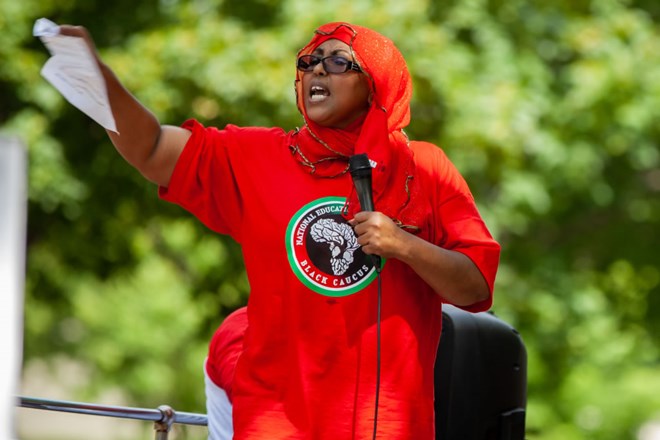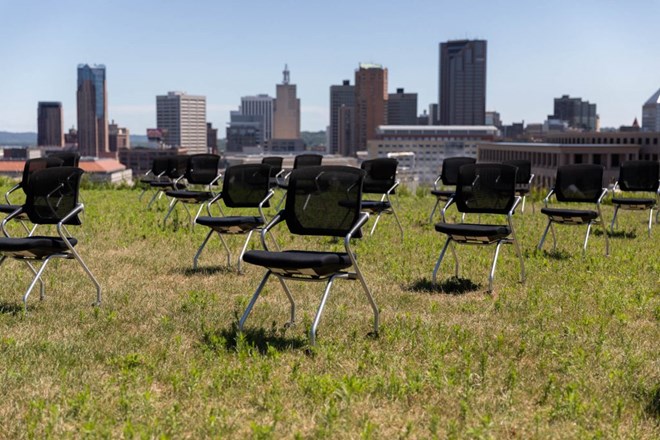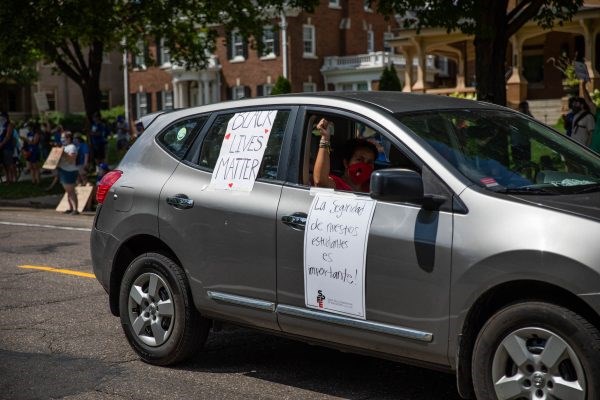
Tuesday July 28, 2020
By BECKY Z. DERNBACH
Many immigrant families came to the United States for an education. But they say safety is more important.

Yasmin Muridi, director of non-licensed personnel of the St. Paul Federation of Educators, said she wanted Governor Walz to hear the voices of Somali families who prefer to continue distance learning. Credit: Jaida Grey Eagle | Sahan Journal
Whittier International School in Minneapolis looks the way Cecilia Laden thought America would look when she arrived from Ecuador. The student body is a diverse and integrated mix of children, about evenly divided among African American, Somali, Latino, and white students. For eight years, Laden has taught Spanish to second through fifth graders, helping them fall in love with her native language. Teaching at Whittier was her first job after college, and she never wanted to go anywhere else.
“I refuse to leave my school,” she said. “I just love it so much.”
But as much as she loves Whittier, Laden doesn’t want to go back to a classroom setting this fall. She knows too many people in her community who have had a family member fall sick with COVID-19.
“It breaks my heart how prevalent COVID has been in the Latino community,” she said. “This is not just statistics in a random newspaper. This is something that I am listening to and seeing with my own eyes. And families are scared.”
As immigrant families wait to hear whether and how schools will resume in-person instruction in the fall, many feel they are being forced to choose between an education–a key reason to come to the United States–and their health. And as the coronavirus pandemic disproportionately sickens and kills people in their communities, many immigrant families feel that distance learning, although not their preferred method of education, is the safest option.
Teachers of color, like parents of color, have more concerns about resuming in-person schooling than their white counterparts, according to a survey from Education Minnesota, the state’s largest teachers union. Minneapolis and St. Paul teachers rallied at the governor’s mansion Friday to demand a remote beginning to the school year. The survey results and rallies came in advance of a highly anticipated Minnesota Department of Education announcement this week on what schooling will look like in the fall.
Governor Tim Walz has indicated he will allow some flexibility for local districts throughout the state, but it’s not yet clear what that might look like. While some students and families are eager to get back to in-person teacher instruction and socializing, teachers from immigrant backgrounds caution that resuming classes in-person will put them, their students, and their communities at an unacceptable risk.
Veronica Castellanos Vasquez, a kindergarten teacher at Emerson Spanish Immersion School in Minneapolis with two elementary school children of her own, worries about exposing herself and her daughters to the virus if school buildings reopen.
“I don’t want to put them at risk because I don’t know how their bodies will respond,” she said. “Maybe they will be fine…but why do I have to expose my family and expose me?”
Castellanos Vasquez thinks it would be safer for her family if she took a job as a tutor this year. She knows her Spanish-language skills would be in high demand for parents looking for a private in-person education alternative. But with her husband now out of work, she can’t take the risk of quitting her teaching job. Many of her students’ parents have lost their jobs, too.
At Laden’s school, too, many families are out of work–and many don’t qualify for unemployment benefits. Some have now returned to their jobs, but only work a few hours a week–not enough to cover the rent. Laden, her colleagues, and parent volunteers have raised tens of thousands of dollars to help some of these families. Still, she’s worried about a potential wave of evictions as protections for renters expire. Some are telling her they don’t want to send their kids back to school because they can’t afford to get sick.

At a rally near the State Capitol Thursday, educators spaced chairs six feet apart to demonstrate what a socially distanced classroom might look like. Teachers unions have called for more state and federal funding to enhance school safety for any level of in-person reopening. Credit: Jaida Grey Eagle | Sahan Journal
Brooklyn Center math teacher Sizi Goyah, who’s running for city council, said regardless of what the state decides, high-poverty schools will need more federal and state funding to make education work during a pandemic. When Brooklyn Center school buildings closed in March, the school didn’t have enough laptops for students. Private philanthropists stepped in to fill the gap, he said. Still, a quarter of Brooklyn Center students didn’t have access to computers or devices needed for remote learning as of mid-May, state data shows.
“If you have to socially distance on a bus, you’re going to have to buy more buses. So we’re going to need a lot more money. And I don’t know where the money is going to come from for poorer communities,” Goyah said. “And if we decide we’re going to go hybrid, we’re still going to need a lot of money for technology.”
He’s also concerned about students’ mental health. The coronavirus pandemic retraumatized many West African people in Brooklyn Center who were affected by the 2014-2016 ebola epidemic in their home countries, he said. Goyah, who is originally from Liberia, lost his sister to ebola. Because of a government mandate not to bury bodies at the time, her body was burned–and she doesn’t have a grave where her family can mourn her. For the West African community, this trauma compounds the disproportionate impact of COVID-19 on Black Minnesotans, Goyah said.
The Centers for Disease Control and Prevention issued guidance late last week calling for the full reopening of schools, backtracking from its own previous health recommendations in a move that aligned with the goals of the Trump administration–to reopen schools as a vital part of reopening the country.
At Friday’s rally, Minneapolis Federation of Teachers president Greta Callahan rejected Trump’s approach.
“Students of color matter, and their lives are not expendable,” she said.
In front of the governor’s mansion in St. Paul on Friday, about 150 teachers carried signs that read “I can’t teach if I’m dead” and “I would die for my students. Please don’t make me.” Still more educators drove down Summit Avenue with messages and signs decorating their cars.

An educator drives down Summit Avenue with signs on the car that read “Black Lives Matter” and “La seguridad de nuestros estudiantes es importante!” — or in English, “The safety of our students is important.” Credit: Jaida Grey Eagle | Sahan Journal
As teachers were rallying Friday, Minneapolis superintendent Ed Graff told Kare 11 that the district’s first choice is “distance learning with supports.” District documents posted online Friday describe this model as layering targeted in-person support of tutoring, technology, and mental health onto a primary instructional model of distance learning.
Still, Minneapolis Board of Education member Kimberly Caprini said in an interview with Sahan Journal that no final decision had been made, and that the district was still waiting for the state’s announcement. Caprini said in-person classes shouldn’t resume until there have been no cases of COVID-19 across the state for 14 days. On Saturday, Minnesota implemented a statewide mask mandate, which could help curb new cases, but it’s too early to see results from that directive. The state reported 650 new cases on Monday.
Castellanos Vasquez knows how socially and educationally beneficial it would be for her daughters, who attend school in Minnetonka, to return to the classroom. Maybe they can go back one day a week, she hopes. “I hope the districts are a little bit flexible,” she said.
Goyah, too, sees how impatient his sixth-grade daughter is to get back to class. “She’s tired of being at home with me,” he said. “She struggled with online. She learns better when she’s in front of an instructor and interacting. I know there’s a lot of students who struggle that way, and I want my daughter to excel.”
Still, teachers say that if distance learning continues in the fall, it will be an improvement over the spring. Students and parents have already adjusted to using the new online platforms. Though some technological gaps remain, districts have distributed many devices and hotspots to many students. Teachers have had more training and learned what online platforms work best for their needs.
Yasmin Muridi, a bilingual family liaison at Highwood Hills Elementary in St. Paul and the newly elected director of non-licensed personnel for the St. Paul Federation of Educators, said she wanted Walz to hear the voices of the Somali families she works with. She can’t imagine telling a young child not to hug her if they fall down and need comfort, or teaching social skills like sharing while keeping kids physically separated, she said. The families she works with feel the same way about resuming in-person classes.